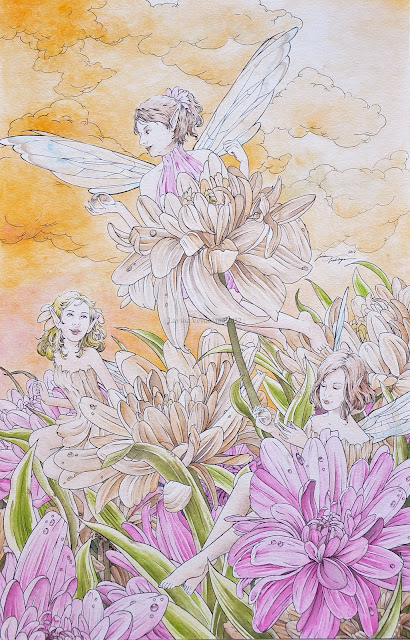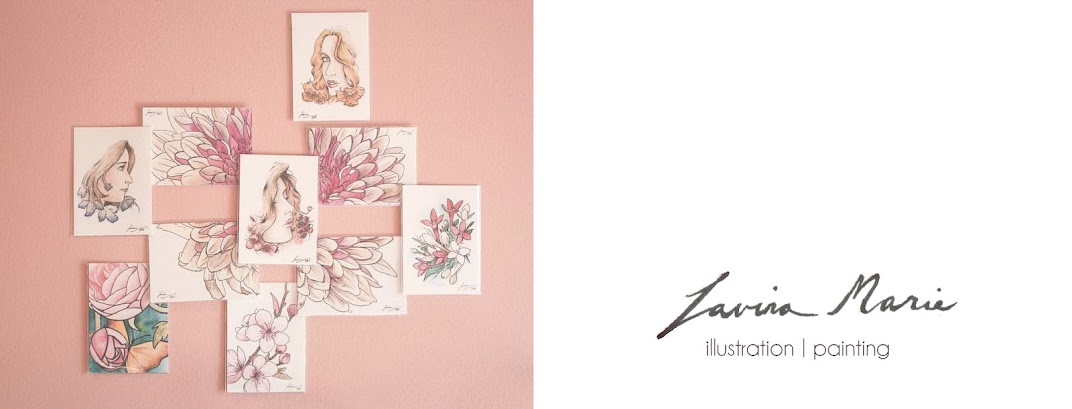Merry Christmas, everyone! :D I hope you and your families are blessed with love and happiness this season. I've been working on a piece and review for some time now, and I can finally share it with you, and in time for Christmas Day too, haha!
 | |||||||||
| Dewfairies at Work Ink and watercolor on illustration board 38.4 x 25.7 cm |
Inktense blocks are water-soluble ink blocks that boast incredible versatility; they can be rubbed dry onto paper like pastels, or else washed with water like paint. I use them like blocks of watercolor, but they're much more vibrant, opaque, and permanent (so permanent, in fact, that my paintbrushes are stained *o*).
Unlike with watercolors, dry Inktense washes can be painted over without affecting the layers underneath. For this reason, it's very difficult to cover up mistakes when using Inktense blocks, as once the ink dries on the paper, it can't be lifted or dissolved. It's funny really; I tend to make mistakes a lot, so every time I would lay the paintbrush down on the paper, I'd hold my breath :))
I had a hard time adjusting to the Inktense blocks; for one reason, they weren't blending at all well with my initial choice of paper (Daler-Rowney), and I couldn't gauge the amount of ink to place onto the paper. Finally, though, after managing to find the perfect paper for the blocks (Bainbridge cold press, a US-made illustration board) and spending a considerable while trying out different mixes and paintbrush load amounts, I discovered that Inktense tends to overpower water.
The blocks are highly concentrated; a single amount mixed with water can already produce a dark, vibrant color on the paper, which can't be effectively blended or removed without first having washed the paper with water. It's thus difficult to use the blocks to create soft paintings, if you're not conscious of your mixes.
 |
| The blocks can be scraped and the shavings mixed with water. |
 |
| I love how the colors just pop, though :D |
Due to their vibrancy, however, Inktense blocks are wonderful for making details stand out, something I'm very partial to. Watercolor tends to fade into the background if not enough paint is loaded into the paintbrush; with Inktense blocks, however, you need only load a little, and it's enough to draw out a bright, clear line on the paper. Moreover, Inktense colors don't bleed into one another as watercolors love to do, a characteristic that I found most useful in painting the under layers of the grass and flowers.
I did use watercolor for some portions of this piece, though, in laying down washes for the sky, and the fairies' skin and hair. I wasn't sure of the effect diluted Inktense would produce, and I didn't want to risk botching the fairies' appearance - and if there's anything I truly hate in my painting, it's botching the fairies.
In a nutshell, Derwent Inktense blocks are a highly versatile medium (and can, in fact, be used on silk and other surfaces), permanent and vibrant. If used like watercolors, they do require a considerable amount of patience and practice, more so than the watercolor medium itself, I think. If mastered, though, these blocks can produce a vast range of rich and beautiful works.
On that note, I'd like to wish you all once again a Happy Holidays, and a wonderful year ahead. ♥
I did use watercolor for some portions of this piece, though, in laying down washes for the sky, and the fairies' skin and hair. I wasn't sure of the effect diluted Inktense would produce, and I didn't want to risk botching the fairies' appearance - and if there's anything I truly hate in my painting, it's botching the fairies.
 |
| I've yet to practice painting skin and hair with the Inktense blocks. |
On that note, I'd like to wish you all once again a Happy Holidays, and a wonderful year ahead. ♥



2 comments
Thanks for sharing your experience. I've used Inktense colored pencils but not the blocks. I think I'll go get some and try them out!
ReplyDeleteHi, Fern! You're welcome! Thank you for taking the time to read the review. Yes, the blocks are really quite something; I hope you have fun with them. :)
Delete